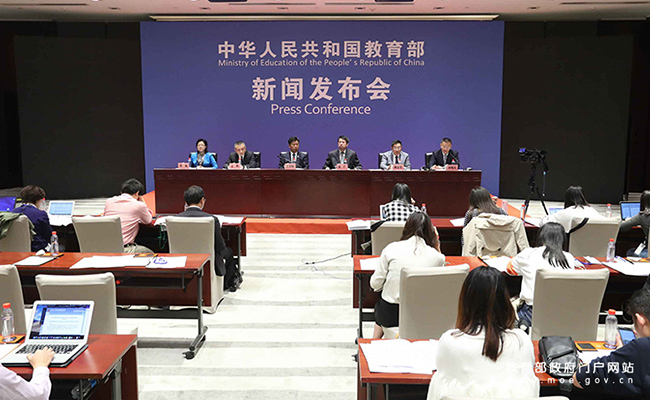
MOE held a press conference on the Comprehensive Plan to Prevent Nearsightedness among Children and Teenagers [Photo/ZHANG Jinsong]
On the afternoon of October 29, a MOE press conference was held in Wuhan, Hubei Province, introducing policy highlights, major action plans and implementation measures of the Comprehensive Plan to Prevent Nearsightedness among Children and Teenagers. This was the first press conference held by the MOE since the recent national education conference, hosted by the MOE spokesperson XU Mei and attended by WANG Dengfeng, Director of MOE’s Department of Physical, Health and Arts Education, officials from local educational authorities and expert representatives.
Director Wang gave a detailed introduction on the background to this topic, and presented the goals and implementation measures set out in the Plan. In recent years, the CPC Central Committee and the State Council has put great emphasis on the physical health of children and teenagers, attaching particular attention to the problem of nearsightedness. At the national education conference convened last month, General Secretary of the CPC Central Committee XI Jinping mentioned in particular the issue of myopia among teenagers, and put forth requirements that physical education of schools should enable students to improve physical fitness, build character and foster perseverance while having fun. Statistics shows that although the physical health of Chinese teenagers had worsened over the past two decades, many of the health indicators used to establish these figures had suggested a gradual improvement over the last five years. However, the prevalence of myopia in students remains an unsolved problem that has become more acute, drawing wide public attention. Nearsightedness may be attributed to certain unhealthy aspects of young people’s daily life, such as the heavy burden of school and homework, coupled with a general inertia in dealing with the problem in children and teenagers. The priority now therefore is to find a way to encourage healthier lifestyles, particularly in children and teenagers. In this sense, the Plan launched by MOE with seven other state agencies will serve as a comprehensive instrument to tackle nearsightedness.
The Plan outlines specific requirements for students, parents, schools, medical and healthcare institutions as well as the government. According to the Plan, by 2023, the overall incidence of myopia among teenagers should be reduced by more than 0.5 percentage points per year from 2018, and provinces with a high number of myopia cases will be required to achieve a reduction of at least 1 percentage point per year.
Based on the Plan, the MOE will focus on the following three aspects. Firstly, all parties involved, including the government, schools, medical and healthcare institutions, parents and students, will be encouraged to take on some responsibility. For example, parents should provide their children with guidance on how to use electronic devices wisely and create more chances for them to have physical exercise and outdoor activities. Secondly, students will be encouraged to participate more in physical exercise and outdoor activities, and their use of screens better controlled, while classroom lighting and seating conditions will be improved. Thirdly, solid efforts will be made on monitoring, services and intervention, on assessment, accountability and improvement, and on awareness raising.
ZHAO Guang, Associate Counsel of Heilongjiang Provincial Education Department, MENG Hui, Director of Wuhan Municipal Education Bureau, and LIN Qiasheng, Deputy Director of Guangzhou Municipal Education Bureau, also shared their experience from local practices in preventing nearsightedness among children and teenagers at the press conference. SUN Xiaodong, an expert representative and Vice President of Shanghai General Hospital, offered suggestions and recommendations for the implementation of the Plan.




